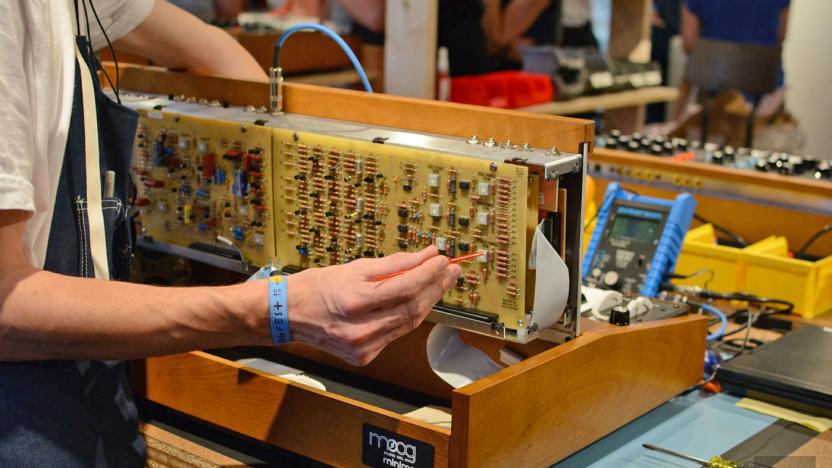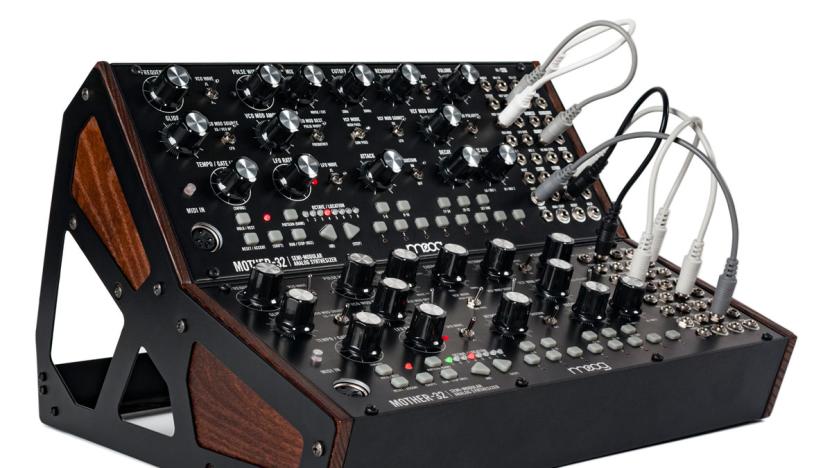analog
Latest

Watchmakers think smart features will beat smartwatches
Fossil is the fourth-biggest watchmaker in the world, responsible for about 5 percent of global timepiece sales. The company produces watches for a variety of brands, including Armani, Kate Spade, Michael Kors and Skagen. This week, ahead of the holidays, all of those labels have launched traditional-looking analog watches that come with activity tracking, notification vibrations and automatic time setting. When a company feels this confident that its users want this tech, you know something's going on. That's because this is the moment that the future of wearables becomes a race to see how deep you can bury your geeky credentials beneath a pretty case.

Fotr takes you back to photography's bad old days
Before digital, photographers of all calibers had to be careful, since there were several limits imposed on what they could do. For instance, you only had a limited number of exposures per reel and you had to pay to print all of your images, even the duds that were destined for the trash. It all sounds dreadful, but that doesn't mean that companies like Fotr aren't going to try and recreate it for the smartphone age. The app, very simply, forces would-be snappers to be as careful as they used to, since Fotr will print out every image you snap with it.

Moog's Minimoog Model D back in full production after 30 years
After suspending production for over 30 years on its classic Minimoog Model D analog synth, Moog has announced the instrument is back. The company had a small pilot production workshop at Moogfest in May, but now Model D production has kicked into high gear. However, just like other Moog synthesizers, all of the instruments are made in a small Asheville, North Carolina factory, so the company can only crank out a limited number of them each month. If you're looking to snag one though, it'll set you back $3,749 from an authorized dealer.

Living circuits can handle complex computing
Gene-based circuits are about to get decidedly more sophisticated. MIT scientists have developed a method for integrating both analog and digital computing into those circuits, turning living cells into complex computers. The centerpiece is a threshold sensor whose gene expression flips DNA, converting analog chemical data into binary output -- basically, complex data can trigger simple responses that match the language of regular computers.

Inside Moog's Minimoog Model D synth factory at Moogfest
When Moogfest kicked off in North Carolina this week, the company announced that the iconic Minimoog Model D was going back into production during the festival. What's more, the analog synths are being assembled on-site at the event right in the middle of a temporary Moog store that's chock full of audio gear. Being the curious folks that we are, we went to check it out the process inside the pop-up factory and watched a little bit of the magic happen in Durham.

Incredibly complex machine plays music with marbles
There have been plenty of impressively elaborate musical machines in recent years, but this might top them all. Swedish band Wintergatan has crafted a Musical Marble Machine that, as the name suggests, churns out tunes using 2,000 marbles (technically, ball bearings). It's a pretty involved effort with 3,000 parts that include a crank, levers, conveyor belts and legions of spinning gears -- Rube Goldberg would be proud, especially if he knew that this beast took 14 months to make.

Korg outs $500 Minilogue analog synthesizer ahead of NAMM
NAMM doesn't start until next week, but that's not keeping Korg from announcing new gear ahead of the show. The pro audio company usually reveals a new synth at the winter soirée, and it looks like this year will be no different. The newest installment is the Minilogue: a polyphonic analog synthesizer with a mighty tempting price. At $500, the instrument offers a truckload of great features at the price of typically reserved for digital synths.

Moog adds to its analog arsenal with the Mother-32 semi-modular synth
Moog announced that it would no longer produce the legendary Minimoog Voyager earlier this week, but that doesn't mean the company isn't slowing down. Today, the North Carolina-based synth maker revealed the Mother-32: a semi-modular analog synthesizer that's built to "inspire unique sound creation, new music and endless sonic exploration." How exactly does it go about doing that? For starters, there's a voltage-controlled sequencer and 32-point analog patch bay to create a load of unique sounds. No patching is required to get started, so musicians at any skill level can begin making music in no time.

Recommended Reading: Science fiction's influence on hip-hop music
Recommended Reading highlights the best long-form writing on technology and more in print and on the web. Some weeks, you'll also find short reviews of books that we think are worth your time. We hope you enjoy the read. The Subversive Science Fiction of Hip-Hop by Rose Eveleth Motherboard I'd never really thought about all of the science fiction references in hip-hop until I read Rose Eveleth's piece for Motherboard that pointed out all of the ties. I listen to a lot of hip-hop, but for some reason, all of the mentions of sci-fi stuff -- from superheroes to dystopia and our human limits -- only got a passing glance from me. This offers a solid look at all of the crossover and serves as further proof that nerdery is universal.

'Blade Runner' tech gives 'Borderlands' its signature sound
"The Commodore 64 is like my Bible; that's when [game] music began because that's when they put an analog chip into a computer," composer Jesper Kyd says of the nearly 33-year-old home computer. "Before that it was PC or Atari and everything was like 'beep, beep, beep, beep-beep beep' and who the fuck wants to listen to that?"

Moog revives its massive modular synthesizers
In 1973, Moog first began manufacturing its huge large format modular synthesizers that pack a wall of knobs, patch cables and other controls. The System 55, System 35 and Model 15 went out of production as musicians desired to have something a bit more portable, but just before the start of NAMM 2015, the company announced those giant setups are coming back. Last year, the folks at Moog remade Keith Emerson's (of Emerson, Lake & Palmer fame) modular system, and during the three-year-long process, learned a thing or two about recreating the original 1970s circuitry. Similar to Emerson's model, the new trio will be "a true recreation of the original," using the decades-old schematics to accurately reproduce the specs -- right down to all of the hand soldering, traditional wiring and photo-etched front panels.

Trade synth hacks and projects on Moog's Werkastatt Workshop hub
Back at Moogfest, the synth maker for which the event is named held a workshop where it debuted the Werkstatt-Ø1 analog kit. The patchable analog instrument was built for hacking, so folks could explore Moog's circuitry (including Ladder filter) in a portable package. After the success of that event back in April the kit is being released to the masses, and the North Carolina-based company is offering up a hub for projects, tutorials, lesson plans and more. The Werkstatt Workshop is similar to libraries that littleBits and Makerbot have for users to find ideas, with a full list of instructions and supplies for each -- including 3D-printing files and Arduino integration as needed. "We'd like to share our legacy of learning, music, and electronics to empower a new generation of makers to expand on our work and take it to levels we can't yet imagine," said Moog Music CEO Mike Adams. Not familiar with the Werkstatt-Ø1 synthesizer? No worries, Chromeo's Patrick "P-Thugg" Gemayel demos the instrument on the other side of the jump, alongside the how-to for building an Arduino Arpeggiator. If you're looking to snag one and get started with the experimentation, it'll set you back $329 at your local Moog dealer.

Redesigned 3DS Circle Pad puts an analog stick under your index finger
Dual-analog controls are pretty standard these days -- two analog sticks on either end of a control pad designed to fall directly under the user's thumbs. Hori's new 3DS slide pad accessory throws this notion out the window: it installs a second control pad on the same side as the handhelds primary input, putting the slider directly behind the console's L button. The accessory is built specifically to accommodate Monster Hunter diehards, but it's not as odd as it sounds: Japanese gamers have made a habit of modifying Nintendo's analog accessory into obtuse and unexpected configurations. Hori's layout is designed to allow players to move their character and manipulate the camera with just one hand, freeing up their right thumb for attacks and in-game actions. The accessory (available in both 3DS and 3DS XL variants) is available in Japan only, for now, to the tune of 2,980 yen.

For $10,000, here's a mechanical watch you'll never have to set
Mechanical watches are beautiful, but there's always the hassle of setting it to the correct time when you travel abroad. What price, then, would you pay to never make that sort of effort again? If you answered "about ten grand," then you're the ideal customer for VCXO's Ox One. The Swiss company has paired up a mechanical movement with a GPS module, so all you need to do is push the -- sigh -- "magic button," and it'll wind the time according to the local satellite. The Stainless Steel version of the watch will set you back $10,000, while the black ceramic is priced at $12,000, but if you're really looking to splash out, there's a limited-edition version that'll set you back nearly $45,000. Of course, if you're that obsessed with accuracy and efficiency, perhaps you're better off just, you know, going digital?

Slighty smarter watches: Casio reveals two new G-Shock concepts
G-Shocks are back -- again. Ready for Swiss timepiece showcase BaselWorld, Casio has announced two new analog concept watches with a little extra soupçon of tech crammed in. The designs still lean towards those looking for a classically-styled (at least, in G-Shock terms) analog watch. Both are expected to last plenty without any regular USB life-support, with the company's latest solar cells there to keep the mechanism and electronics going. First up, the Edifice EQB-500 connects to smartphones using Bluetooth 4.0 Low Power (Casio's first analog watch to do so). It's a loose allegiance though, covering time information and alarm settings which can also be programmed through the phone -- it's still very much a watch, not a Pebble rival. Casio's second model is the more technically accomplished one: the first watch to pair together both GPS and Radio Wave tech, all without any unwieldy lumps in the design.

Moviefone's phone service shutting down after 25 years
When your service is more fondly remembered as a Seinfeld plot than as something people use, it's probably time to drop the mic. After a quarter-century, Moviefone's movie-times hotline is winding down, as users abandon the phone in favor of sites like Fandango. The AOL-owned company isn't fading quietly into the night, however, as Moviefone's mobile app and website will still live on in their current form -- for now, at least.

Build your own analog synthesizer with Korg's MS-20 kit
At NAMM 2013, we were able to get cozy with Korg's MS-20 mini analog synth. This year, the company is putting the wrenches in your hands with its DIY MS-20 kit. For $1,400, synthesizer enthusiasts can nab the collection of parts needed to construct a working model of the iconic instrument, with no soldering or electrical expertise required. You can expect all the features, specs and even the same circuit path from the original with new MIDI input and USB connections. The kit remains true analog with 1/4-inch patch bay to boot, just in case you were concerned. There's even two types of filters that pay homage to both the early versions and the later more mellow MS-20 sounds, toggled on the circuit board. Heck, the engineers of 1978's original oversaw the process to insure the components replicated the circuitry of that synth. Only 1,000 kits will be available, so you'll have to act quickly when packages become available in March.

Successor to the iconic Roland TR-808 drum machine teased in promo video
What you see here is a leaked image that claims to be the upcoming successor to the classic TR-808 drum machine from Roland. If you're in need of a refresher, the unit debuted in 1980 and powered a truckload of iconic sounds over the past 30 years, including Marvin Gaye's "Sexual Healing" and Afrika Bambaataa's "Planet Rock." Heck, it's still getting plenty of use by musicians and producers today. In a video teaser discussing the heritage of the original device, Roland's Atsushi Hoshiai notes that the outfit feels "it's time to take the next step." Near the end of the video, you'll catch a glimpse of what appears to be the new drum machine -- labeled the AIRA -- that matches up well with the snapshot. A green-rimmed black unit is flashed briefly and what's shown of the button layout seems to match up with that image obtained by Attack Magazine. Details are scarce at this point, but the big question is whether the AIRA will be a brand-new digital version or a reissue that's analog like the original. It's also worth noting that Korg has gone analog with recent product launches, like the Volca synth series and MS-20 mini, so hopefully Roland will follow suit. We're just days away from NAMM 2014, so the new unit may get a proper unveiling in Anaheim... if we're lucky. The aforementioned video awaits just past the break, so you can have a look for yourself.

DualShock 4 drops analog buttons, citing lack of interest
For the first time since 1997, Sony is stepping away from releasing controllers with pressure sensitive, analog buttons, thanks to a lack of developer support for the feature. Unlike prior controller models, the DualShock 4 features digital buttons. These buttons are only capable of registering two states: on and off. Analog controllers, on the other hand, offer sensitivity for how hard and how quickly a button is depressed. A good example of this functionality can be found in Gran Turismo 5, a racing game that allows players to gradually accelerate by slowly pressing the shoulder buttons of the DualShock 3 controller. Unfortunately for analog fans, Gran Turismo 5 is one of the very few examples of analog functionality in action on the PlayStation 3. This is why the feature has been stripped from the DualShock 4. "With the DualShock 3, we were able to get analog data, which games didn't really use," said Toshimasa Aoki, manager of Sony's product planning division, in a VentureBeat interview. "For DualShock 4, we deleted that, and now it's all digital. The mechanism inside is a little different, and the data that games get is different."

High fidelity: Inside John Vanderslice's Tiny Telephone analog studio
"There are a lot of records that I love that clearly have a Pro Tools imprint of them that just sound like sh**," answers John Vanderslice, excitedly. Though that last part really goes without saying. If there's anything about which the musician isn't passionate, we certainly haven't discovered it during the hour or so we've been at his Tiny Telephone studio. Talking to Vanderslice is less a conversation than it is immersion therapy in musical enthusiasm. "And these are great bands," he continues. "I actually refrain from being specific because I often know the people that have recorded them, that have mastered them. These are bands operating at the prime of their career. This represents two or three years of their creative thinking and their work, and they're making a five-minute decision to record on this medium versus this medium. It isn't cheaper or more expensive. It's a tragic decision." Of course, anyone with a passing familiarity with Vanderslice will happily tell you there's one subject about which he's particularly passionate. And indeed, we're currently standing in one of the last remaining shrines to the dying art of analog recording, housed in a shed-like building in an enclave of artist spaces at the end of a quiet San Franciscan side street. When we first arrived, a bit on the early side for a Sunday morning, the former Mk Ultra frontman was beaming beneath a patch of blue dye on platinum-blond hair. It's an expression that won't leave his face for the duration of our stay, even when the conversation turns to Pro Tools, something of a dirty word around the 1,700-square-foot studio, which boasts Wurlitzers, Hammonds and grand pianos. There's an ancient harpsichord, a 1976 Neve 30-channel board, reel to reels and a room full of tape. It's a bit like stumbling into Phil Spector's bomb shelter.







